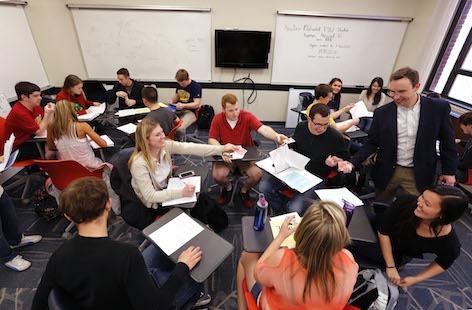
Students huddle in small groups during a CLPS 332 class in Gilman 2104. Designed to promote "active" learning, the classroom is equipped with multiple monitors, white boards and desks on wheels for small group sessions. Photo by Christopher Gannon.
Can a classroom's physical space make learning easier and more impactful? Melissa Rands, a doctoral candidate in the School of Education with an emphasis on research and evaluation, says absolutely -- and she has the data to back it up.
Classroom funding
Iowa State has a 10-year plan in place that will upgrade all 214 general university classrooms.
Last year, the Center for Excellence in Learning and Teaching (CELT) asked Rands to assess the effectiveness of 2104 Gilman Hall, an active learning classroom that was remodeled in 2013 by CELT with the help of a $300,000 grant. Rands conducted focus groups with faculty and students familiar with 2104 Gilman, and presented her findings at a CELT seminar on March 5.
What is an active learning classroom?
An active learning classroom is not your mother's classroom. Instead of a teacher presiding over rows of students sitting in desks, an active learning classroom consists of components, both low- and high-tech, that make learning more interactive. In 2104 Gilman, these items include:
- Moveable tablet-arm chairs
- Document camera
- DVD/video/computer output projection
- Huddle boards (portable white boards)
- Monitors throughout the room
- Writing surfaces greater than 35 linear feet
The questions
Rands asked the focus group participants to describe:
- How they used the classroom and its features
- The impact of the classroom design on teaching and learning
- Aspects of the classroom's design that need to be changed to promote active learning
The results
Rands discovered students used the moveable chairs most often for collaborative work, and the huddle white boards to visually bring their ideas to life. Faculty also used the huddle boards for quick classroom assessments. For example, the small groups would write answers on the huddle boards so the instructor could quickly determine how well the students understood the information. The least used -- and perhaps the least understood -- devices in the classroom were the supplemental monitors. Both students and instructors felt they weren't technically savvy enough to use the monitors effectively.
One of the biggest benefits of 2104 Gilman, Rands found, is the flexibility to change the classroom space to accommodate various active learning situations. Students and faculty said they could move in and around the space easily, achieving greater interaction between the students and the instructor. Students in the focus group told Rands that they felt the physical space of 2104 Gilman "erased the line" between the students and the teacher, resulting in a learner-centered environment.
Some tweaks
The focus groups gave 2104 Gilman high marks, but there still is room for improvement. When Rands asked what aspects of the classroom design needed to change, students and faculty said the space could use:
- An area for personal belongings
- The option to remove or store excess chairs and desks
- Better acoustics
- Larger tables or work surfaces
Faculty also said they would appreciate training on how to better use the room's technological capabilities.
Conclusion
Following her analysis of the focus groups, Rands concluded:
- Committing resources to classroom redesign to promote active learning is a worthwhile investment
- Low-cost additions and learning tools were cited as the most effective features of 2104 Gilman
- Classrooms should be assessed using flexibility and adaptability as the criteria
- Tech tools require training
- Students should participate in the design and evaluation of learning spaces
For more information about using 2104 Gilman, contact room scheduling, 294-4493.

